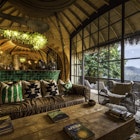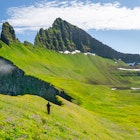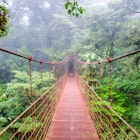
Rwanda is a land of outdoor adventure
Sponsored by

Nov 30, 2023 • 6 min read

© Image courtesy of Visit Rwanda; Graphics by Dustin Johnson / Lonely Planet
If you’re heading to Rwanda and have a taste for adventure and outdoor activities, you’ll be spoiled for choice. For such a small country, there’s a startling variety of pulse-quickening adventure options.
There’s no better ecofriendly way to experience Rwanda’s wild beauty than on foot or from a bike saddle. There are also rivers and lakes to paddle and caves to explore. And if after all that exercise you want to recharge the batteries, a couple of expanses of white sand beckon.

Cycling along the Congo Nile Trail
For an exhilarating (yet safe) biking experience, nothing beats the Congo Nile Trail (CNT).
Well off the beaten path, this is both a cycling and hiking itinerary that runs along the shores of Lake Kivu, one of Africa’s great lakes, in western Rwanda. Launched in 2009, it uses a series of interconnected rural paths, dirt road and drivable tracks through the tropical Kivu Region. Running roughly parallel to the eastern shores of the lake for 140 miles (227km) from Gisenyi to Kamembe, the ride can be completed in about five days.
Expect a unique adventure amid rolling hills, vast coffee plantations and fascinating tropical forests – not to mention phenomenal lake views. Cycling is not the only focus, it’s also a great way to meet locals and share traditional activities, including craft making, honey harvesting, visiting tea or coffee estates or joining local fishermen as they spend the night fishing sambaza (small fish).

The icing on the cake: there are also plenty of hidden beaches along the way where you can take a dip. There aren’t any dangerous animals living in the lake (read: no hippos and no crocs) so it’s perfectly safe – and recommended – to refresh on a beach after a day’s biking the trail.
You can tackle the Congo Nile Trail on your own, but a guide is invaluable. Contact the specialist operator Rwandan Adventures. Its bikes, including e-bikes, are in tip-top condition and the guides are well qualified. You don’t need to have iron thighs to cover the itinerary, but it’s best to be reasonably fit and trained before hitting the trail.
There are various types of accommodation along the way. The guides can arrange camping, but if tents or campsites are not your things, there are homestays, guesthouses and small lodges you can opt to stay in. And what about meals? You’ll enjoy fresh, delicious food prepared by locals. Many villages also have shops where you can purchase snacks, fruits and water.

Volcanoes and caves
For most travelers, Musanze (Ruhengeri), and nearby Kinigi, are the choice staging posts for the magnificent Volcanoes National Park, one of the best places in East Africa to track mountain gorillas. The towns are situated near several interesting natural sights, including a few spectacular caves, which lie just over a mile (2km) from the town center along the road to Gisenyi. They were created when different lava flows joined to create the Albertine Rift Valley.
Bat roosts are a significant feature of the caves, as are huge roof collapses that create vast arrays of colored light shafts – incredibly photogenic! You don’t need to be a superhero to explore these caves, but a guide is required.
Still have stamina? Head to Lake Ruhondo and Lake Burera, also on the outskirts of Musanze. The two large lakes are dotted with small villages and accessed via a network of dirt roads.
The scenery here is breathtaking as the shores of the lakes are heavily terraced and cultivated with crops, and the Virunga volcanoes loom ominously in the distance. While Ruhondo and Burera lack tourist infrastructure, you can easily have a do-it-yourself adventure here, especially if you have your own transport (or if you’re keen on walking) and are able to arrange a lake trip with a local fisherman.

Walking on a Canopy
Wan to try something different? How about reliving a scene from Avatar?
Suspended above a ravine in the lush montane rainforest of Nyungwe Forest National Park, you’ll appreciate the jungle anew from a unique monkey’s-eye perspective. This 500-foot-long (160m) and at times 230-foot-high (70m) construction ranks as one of the most spectacular canopy walkways in the world, and a big draw for visitors after something unusual.
The canopy walk provides memorable views of the surrounding forest and is accessible after a preliminary 30-minute ascent. You’ll see plenty of butterflies, orchids and colorful birds on the way.

Kayaking on Lake Kivu
Lake Kivu is Rwanda’s largest body of water and a fantastic playing ground for outdoorsy types. If playing sardines on the beach in the popular resort town of Gisenyi ceases to do it for you, you can take a kayak excursion to explore the blue and clear waters that lap the scenic shores of the lake.
There are plenty of sandy inlets where you can stop and relax while watching a number of bird species that dart in and out of the surrounding bushes. Fear not, paddling is super safe as there are no hippos or crocs. You’ll find peace and tranquility on the quiet waters and feel the caress of the breeze, with the volcanic mountains as an astounding backdrop.
It’s also a great opportunity to approach the fisherfolk on their superb traditional wooden boats. You may hear them singing rhythmically as they paddle out in unison – a memorable experience. On a day trip you can investigate small islands and enjoy a picnic. You can also choose an overnight and spend the night camping on an uninhabited island – the perfect Robinson Crusoe experience, Rwanda-style.
Kingfisher Journeys is a reputable outfit that runs guided kayak trips. No previous experience or skills are required.

Climbing the Volcanoes in the Virungas
West of Rwanda, the iconic summits of the Volcanoes National Park are an absolute must-see. Although this area is world-famous for gorilla-watching, there is a variety of rewarding climbing and trekking options in the park too. A few options include Karisimbi (14,000-ft; 4507m; two days); Bisoke Crater Lake (seven hours return); Ngezi (three hours return); Dian Fossey’s Grave (five hours return); Gahinga (11,000-ft; 3474m; eight hours return); and Muhabura (13,500-ft; 4127m, nine hours return).
As you make your way along the ascents, you’ll pass through some remarkable changes of vegetation, ranging from thick forests of bamboo and giant lobelia or hagenia on to alpine meadows. And there are further rewards in store: if the weather is favorable, you can enjoy spectacular views over the mountain chain.
There are several possibilities for climbing up to the summits of one or more of the volcanoes in the park, with treks ranging in length from several hours to two days. A guide is compulsory and is included in your trekking fee; additional porters are optional (US$20 per day).
One of the best parts of climbing and trekking the volcanoes is that you will be awarded ample opportunities to view wildlife (sans gorillas and golden monkeys, of course). The most common herbivores in the park are bushbucks and black-fronted duikers; buffaloes, bush pigs and giant forest hogs are infrequently spotted. Also, be sure to inspect the hollows of trees for hyraxes, genets, dormice, squirrels and forest pouched rats. The richest birdwatching zone is in the hagenia forests, where you can expect to see turaco, francolins, sunbirds, waxbills, crimson-wings and various hawks and buzzards.
Sponsored by Visit Rwanda
As a travel entertainment and inspirational media outlet, we sometimes incorporate brand sponsors into our efforts. This activity is clearly labeled across our platforms.
This story was crafted collaboratively between Visit Rwanda and Lonely Planet. Both parties provided research and curated content to produce this story. We disclose when information isn’t ours.
With sponsored content, both Lonely Planet and our brand partners have specific responsibilities:
Brand partner
Determines the concept, provides briefing, research material, and may provide feedback.
Lonely Planet
We provide expertise, firsthand insights, and verify with third-party sources when needed.
Explore related stories



 Wildlife & NatureGabon aims to become Africa's off-the-beaten-path safari destination in 2023
Wildlife & NatureGabon aims to become Africa's off-the-beaten-path safari destination in 2023Mar 27, 2023 • 5 min read
 Wildlife & NatureHow African safari lodges are putting local creativity front and center
Wildlife & NatureHow African safari lodges are putting local creativity front and centerJan 12, 2023 • 9 min read



 Sustainable TravelStroll through the treetops on the world's best forest canopy walkways
Sustainable TravelStroll through the treetops on the world's best forest canopy walkwaysJan 8, 2021 • 6 min read
 National ParksThis Rwandan national park and biosphere reserve is opening to primate trekking
National ParksThis Rwandan national park and biosphere reserve is opening to primate trekkingNov 18, 2020 • 2 min read
